Business agility is no longer a luxury but a necessity for organizations aiming to thrive in the modern business world. Companies must swiftly adapt to market shifts and technological advances to stay competitive. Investing in agility is no longer optional; it's essentially important for success in an ever-changing business environment.
Our article explores the topic of business agility in depth, supported by industry and data insights.
What Is Business Agility?
Business agility is a set of organizational capabilities and ways of working enabling companies to achieve their goals by being flexible and resilient. It portrays organizations' ability to adapt swiftly and efficiently to the changes in the business environment.
The business agility concept encompasses not only IT or operational changes but also involves strategic, structural, cultural, and other types of change. Business agility aims to provide a sustainable competitive advantage to organizations and teams.
4 Essential Competencies of Business Agility
At the heart of business agility are four core competencies:
1. People-First Leadership: This involves guiding organizations through transformation, focusing on Agile principles and practices. In an Agile business context, leaders empower teams, foster a collaborative environment, and ensure that decision-making is decentralized. Traditional leadership is replaced by shared leadership, where managers are coaches and facilitators.
2. Engaged Culture: The culture of an Agile organization is characterized by flexibility, openness to change, and a learning mindset. It values experimentation, accepts failures as learning opportunities, and encourages constant feedback and communication across all levels of the organization.
3. Flexible Operations: This includes adopting Agile methodologies, like Scrum or kanban, in operational processes. Agile operations are iterative, incremental, and focusing on delivering value to customers quickly and efficiently. They rely on cross-functional teams and emphasize continuous improvement.
4. Value-based Delivery: An Agile organization prioritizes delivering value to customers. This involves understanding customer needs deeply and responding to them through rapid and flexible product or service development. It's about delivering what the customer values, not just following a plan.

Why Is Business Agility Important?
Here are three prominent reasons for the rising significance of business agility in organizations and the crucial changes in leadership driving Agile transformations.
Three-Year Mark Critical for Significant Benefits in Business Agility Transformations
Achieving business agility is a transformative journey that takes time and dedication, with significant benefits often materializing after three years. This continuous process involves implementing iterative changes and fostering a culture of adaptability within an organization. Companies looking to enhance their agility must embrace this as a dynamic evolution, not a one-time goal. By consistently adapting to market changes and internal shifts, businesses can sustain growth and competitiveness in an ever-evolving corporate landscape.
Business Agility Is Recognized as a Priority across Organizations
67% of organizations agree that business agility is a high priority within their companies. This underscores a growing recognition of the importance of responding swiftly and effectively to market changes and operational challenges.
Growing Need for Shift in Leadership
The necessity for agility is evident as organizations navigate through economic difficulties and remarkable shifts in the work environment and employee contentment. There is a strong relationship (0.86 correlation) between leaders who adopt leadership styles focused on fostering working environments in which team members feel empowered and the ability of their organizations to swiftly and efficiently react to market obstacles and prospects.
What Are the 4 Critical Benefits of Business Agility?
Business agility competencies enable organizations to be more responsive, customer-centric, efficient, and ultimately more successful in achieving their business goals. The growing importance of business agility to organizations is related to several key factors.
Increased Business Outcomes Delivery
As confirmed by the 2023 Business Agility report, Agile organizations are better positioned to achieve their business goals, including financial benefits. This is because agility enhances the ability to navigate complex and changing business environments. Agile practices focus on setting and achieving short-term objectives within broader strategic goals. This iterative approach allows for constant re-evaluation and adjustment of strategies to ensure alignment with the overall strategy. Furthermore, the efficient processes and reduced waste inherent in Agile operations can lead to cost savings, positively impacting the bottom line.
Greater Customer Satisfaction
Business agility allows organizations to respond quickly to changing customer preferences and expectations. By adopting Agile practices, companies can more effectively tailor their products and services to meet customer needs, leading to higher satisfaction. Agile businesses are adept at gathering and integrating customer feedback into their delivery cycles, ensuring the value aligns closely with customer desires.
Managing Transformation Initiatives
In an era of digital transformation, business agility is essential. Agile organizations can implement transformation initiatives more effectively because they are accustomed to change and continuous improvement. They can quickly pivot and adapt their strategies in response to new technologies, market trends, and business challenges, making the transformation process more seamless and less disruptive.
Improving the Speed to Market
One of business agility's most significant advantages is the increased market speed. Agile businesses can develop and deliver products and services faster than their less agile counterparts. This rapid delivery is crucial in a competitive market where being first can often mean the difference between capturing market share and being left behind. Faster development cycles, coupled with continuous deployment and integration, mean that Agile organizations can capitalize on opportunities as they arise.
How to Implement Business Agility? Best Practices
Let's look at the following example. Your organization is a technology company facing rapidly changing consumer demands and technological advancements. To stay ahead in this highly competitive market, you set out to quickly improve your organizational capabilities to adapt to emerging trends and customer needs. In this context, the path to transforming business agility may include the following steps:
- Establishing Agile Teams: Your organization should aim to form cross-functional teams that work in short, iterative cycles, constantly gathering customer feedback and adapting the product or service accordingly.
- Decentralizing Leadership Model: The leadership should support this by providing a vision but allowing teams to self-organize in how they achieve it.
- Embracing Transformational Culture: The culture needs to be shifted to embrace change and learn from failures, focusing on quickly delivering real value to customers.
- Adopting Agile Practices: Instead of sticking to a rigid, long-term product development plan, aim to adopt Agile practices. For instance, you can explore integrating methodologies like Scrum and Kanban into your organization's workflow. These practices focus on frequent delivery, continuous feedback, and team collaboration to make operations more efficient.
- Embracing Lean Portfolio Management: LPM involves applying Lean and Agile principles at the portfolio level to optimize the flow of value through a series of projects or services. It focuses on aligning initiatives with business objectives, prioritizing work based on value, and managing investment funding in a more flexible, adaptive manner.
- Implementing Value Streams: Value streams help visualize how value is created and uncover inefficiencies in the flow of work. Analyzing the entire value delivery system through value stream management provides critical insights for optimizing workflows system-wide rather than just locally.
Business Agility Metrics Across the Organization
Although business agility is more of a behavior, it can be quantitatively measured using several key metrics.
Flow Metrics: Flow metrics focus on the movement and progress of work through an agile system.
- Work in Progress (WIP): The number of work items or projects being worked on.
- Cycle Time: The time it takes to complete a piece of work from start to finish.
- Throughput: The number of work items passing through a system over a set period.
Outcome Metrics: These metrics evaluate the results and impact of Agile practices.
- Customer Satisfaction: Measures how well the products or services meet customer expectations.
- Business Value Delivered: Assesses the value created for the business, often in financial terms.
- Quality Metrics: Evaluate the quality of the work produced, often through defect rates or customer feedback.
Other Metrics: Various other metrics can also be used, such as:
- Employee Engagement: Gauges the level of commitment and satisfaction among employees.
- Market Responsiveness: Measures how quickly an organization can respond to market changes.
- Innovation Rate: Assesses the frequency and effectiveness of new ideas or improvements being implemented.
These metrics provide a comprehensive view of how effectively an organization is assessing its business agility, allowing adjustments and improvements based on quantitative data.
The Cornerstone of Business Agility – Lean Portfolio Management
Traditional siloed thinking cannot respond to the necessities of the hectic pace of emergent disruptions across industries. Instead, organizations should focus on value streams across various business functions. Furthermore, this creates an environment where value delivery is focused on multiple and fast iterations to understand the customer's needs better and adapt to the modifications of those expectations.
Lean portfolio management (LPM) is an approach that proposes a holistic way for companies to manage their project portfolios effectively in a challenging environment. It equips organizations to quickly and effectively adapt to fluctuating market conditions, shifting requirements, and various uncertainties.
Here’s an overview of how LPM promotes a flexible and open system by integrating Lean principles and Agile methodologies.
Improved Portfolio Visibility
Lean portfolio management enhances the delivery capabilities through full visibility into the projects and initiatives at hand.
Using Businessmap, for instance, we create management workspaces and portfolio boards, enabling a unified view of all our projects and programs in one central spot. This setup allows for tracking project progress across teams at a glance.
Next, we map all the team's work and ensure we link the entire structure together. This way, we visualize all high-level projects/initiatives and keep track of all building blocks without switching between different systems.
Businessmap allows to apply this approach across organizational levels, from teams to strategic C-level initiatives, covering product, project, and program management.
 Breaking down top-level initiatives into team projects using a portfolio board in Businessmap
Breaking down top-level initiatives into team projects using a portfolio board in Businessmap
Aligned Strategy with Execution
Establishing an effective connection between operations and strategic vision is vital for improving the adaptability of any business. OKRs serve as a robust framework within Lean portfolio management, streamlining goal setting, tracking, and alignment. When utilized effectively, OKRs help organizations align portfolio initiatives with strategic goals and promote ongoing enhancement.
To do that in practice, Businessmap offers measurable outcomes to visualize OKRs, set goals across the organization, and track how day-to-day work contributes to achieving those goals.
 Connecting strategic and team-level OKRs on a portfolio board in Businessmap
Connecting strategic and team-level OKRs on a portfolio board in Businessmap
Relying on Business Cases with MVPs
Compared to traditional portfolio management, where projects are undertaken based on speculative project details such as ROI, LPM promotes the development of business cases using the minimum viable product (MVP) concept. MVP is an early iteration of a solution used to test and assess the core business assumption. A successful MVP should help to break down the solution into epics. Completing these epics should steer the entire project portfolio toward the desired strategic goal.
Managing Value Streams
Besides decentralized decision-making and dynamic planning processes, LPM also promotes structuring work using outcome-focused value delivery. Value stream maps are key in this approach, pinpointing waste to streamline delivery and enhance cross-departmental operations, ensuring successful portfolio execution.
 Mapping an end-to-end procurement process using Businessmap
Mapping an end-to-end procurement process using Businessmap
We offer the most flexible software platform
for outcome-driven enterprise agility.





